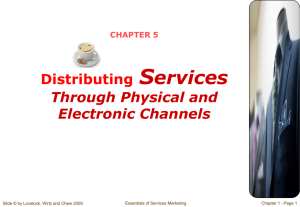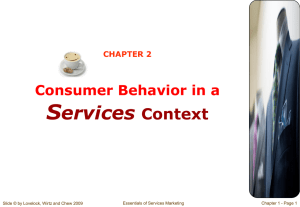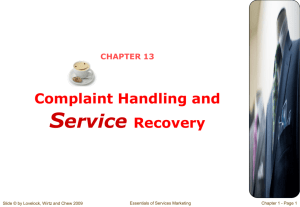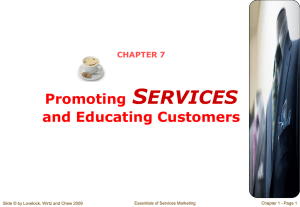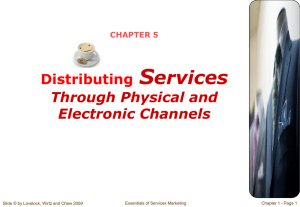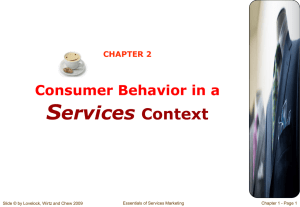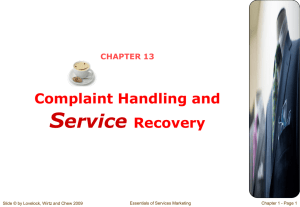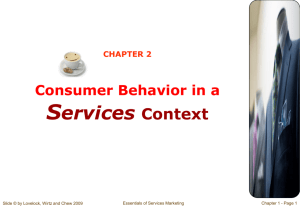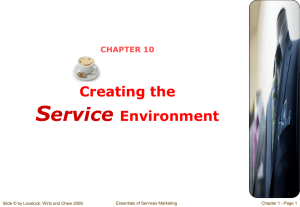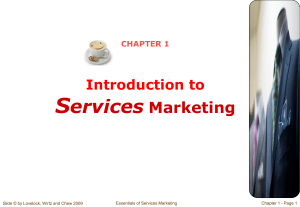Chapter 4
advertisement
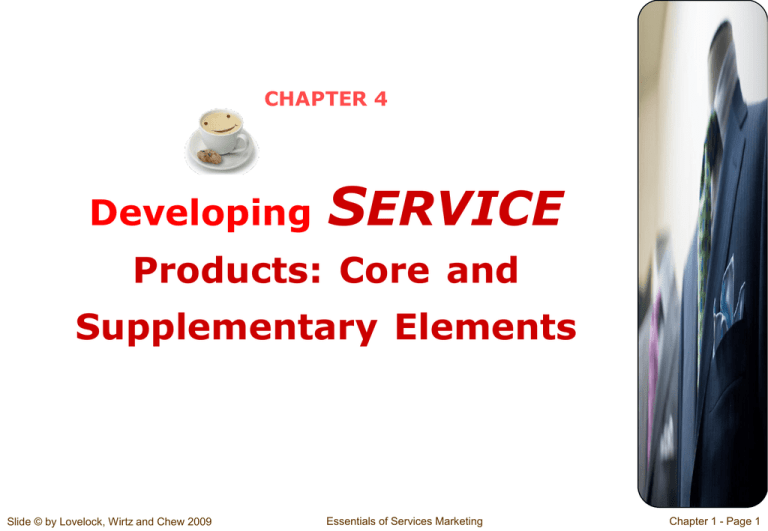
CHAPTER 4 Developing SERVICE Products: Core and Supplementary Elements Slide © by Lovelock, Wirtz and Chew 2009 Essentials of Services Marketing Chapter 1 - Page 1 Service Product A Service Product comprises all elements of service performance, both tangible and intangible, that create value for customers. Consists of: A Core Product Supplementary Services Delivery Processes Slide © by Lovelock, Wirtz and Chew 2009 Essentials of Services Marketing Chapter 1 - Page 2 Designing a Service Concept (1) Core Product Central component that supplies the principal, problem-solving benefits customers seek Supplementary Services Augment the core product’s appeal - facilitating elements (usually necessary) - enhancing elements (usually optional) Delivery Processes Used to deliver both the core product and each of the supplementary services Slide © by Lovelock, Wirtz and Chew 2009 Essentials of Services Marketing Chapter 1 - Page 3 The Flower of Service (2) There are two kinds of supplementary services Facilitating supplementary services – either needed for service delivery, or help in the use of the core product Enhancing supplementary service – add extra value for the customer Market positioning and pricing strategies determine which supplementary services are included Slide © by Lovelock, Wirtz and Chew 2009 Essentials of Services Marketing Chapter 1 - Page 4 Designing a Service Concept (2) Service product design must address the following issues: How the different service components are delivered to the customer The nature of the customer’s role in those processes How long delivery should take The recommended level and style of service to be offered Slide © by Lovelock, Wirtz and Chew 2009 Essentials of Services Marketing Chapter 1 - Page 5 The Flower of Service (Fig 4.4) (1) Information Payment Billing Consultation Core Exceptions Order-Taking Hospitality Safekeeping KEY: Facilitating elements Enhancing elements Slide © by Lovelock, Wirtz and Chew 2009 Essentials of Services Marketing Chapter 1 - Page 6 Supplementary Services (1) Facilitating Elements Information – educate customers on how to obtain and/or use a product or service Order-Taking –should be easy, fast and smooth Billing – Bills should be simple to follow, clear, accurate and intelligible Payment – Make transactions simple and convenient Slide © by Lovelock, Wirtz and Chew 2009 Essentials of Services Marketing Chapter 1 - Page 7 Supplementary Services (2) Enhancing Elements Consultation – offer advice and consultation tailored to each customer’s needs and situation Hospitality – treat customers as welcome guests Safekeeping – store customers’ personal possessions brought to the service site Exceptions –special requests, exception (problem) handling Slide © by Lovelock, Wirtz and Chew 2009 Essentials of Services Marketing Chapter 1 - Page 8 Facilitating Services – Examples of Information (Fig. 4.5) Slide © by Lovelock, Wirtz and Chew 2009 Essentials of Services Marketing Chapter 1 - Page 9 Facilitating Services – Examples of Order-Taking (Fig. 4.7) Slide © by Lovelock, Wirtz and Chew 2009 Essentials of Services Marketing Chapter 1 - Page 10 Facilitating Services – Examples of Billing Slide © by Lovelock, Wirtz and Chew 2009 Essentials of Services Marketing (Fig. 4.9) Chapter 1 - Page 11 Facilitating Services – Examples of Payment (Fig. 4.10) Slide © by Lovelock, Wirtz and Chew 2009 Essentials of Services Marketing Chapter 1 - Page 12 Enhancing Services – Examples of Consultation (Fig. 4.11) Slide © by Lovelock, Wirtz and Chew 2009 Essentials of Services Marketing Chapter 1 - Page 13 Enhancing Services – Examples of Hospitality (Fig. 4.13) Slide © by Lovelock, Wirtz and Chew 2009 Essentials of Services Marketing Chapter 1 - Page 14 Enhancing Services – Examples of Safekeeping (Fig. 4.14) Slide © by Lovelock, Wirtz and Chew 2009 Essentials of Services Marketing Chapter 1 - Page 15 Enhancing Services – Examples of Exceptions (Fig. 4.15) Slide © by Lovelock, Wirtz and Chew 2009 Essentials of Services Marketing Chapter 1 - Page 16 Product Lines And Brands Most service organizations offer a line of products rather than just a single product. Branding can be used at both company and product levels Three Brand Alternatives: Single brand to cover all products and services A separate, stand-alone brand for each offering Some combination of these two extremes Slide © by Lovelock, Wirtz and Chew 2009 Essentials of Services Marketing Chapter 1 - Page 17 Spectrum of Branding Alternatives (Fig 4.18) Source: derived from Aaker and Joachimsthaler Slide © by Lovelock, Wirtz and Chew 2009 Essentials of Services Marketing Chapter 1 - Page 18 A Hierarchy of New Service Categories (1) 1. Style changes Visible changes in service design or scripts 2. Service improvements Modest changes in the performance of current products 3. Supplementary service innovations Addition of new or improved facilitating or enhancing elements 4. Process-line extensions Alternative delivery procedures Slide © by Lovelock, Wirtz and Chew 2009 Essentials of Services Marketing Chapter 1 - Page 19 A Hierarchy of New Service Categories (2) 5. Product-line extensions Additions to current product lines 6. Major process innovations Using new processes to deliver existing products with added benefits 7. Major service innovations New core products for previously undefined markets Slide © by Lovelock, Wirtz and Chew 2009 Essentials of Services Marketing Chapter 1 - Page 20 Success Factors in New Service Development Market synergy Good fit between new product and firm’s image/resources Advantage vs. competition in meeting customers’ needs Strong support from firm during/after launch Firm understands customer purchase decision behavior Organizational factors Strong cross-functional cooperation and coordination Internal marketing to educate staff on new product and its competition Employees understand importance of new services to firm Market research factors Scientific studies conducted early in development process Product concept well defined before undertaking field studies Slide © by Lovelock, Wirtz and Chew 2009 Essentials of Services Marketing Chapter 1 - Page 21
